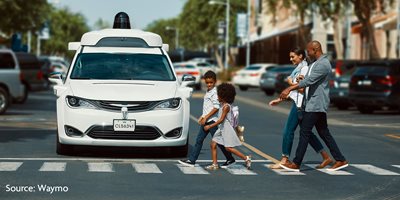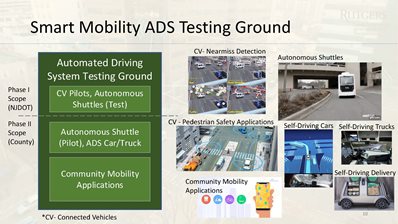
It might be hard to imagine a taxi or delivery van travelling the roads transporting people and goods all without a driver behind the wheel. But Waymo is testing these vehicles on Arizona roads today.
New Jersey will also soon be a testing ground for connected and autonomous vehicles thanks to a project being spearheaded by the Center for Advanced Infrastructure and Technology at Rutgers University, in partnership with Middlesex County, the New Jersey Department of Transportation (NJDOT) and several academic and private partners.
These initiatives were among the presentations made during a recent NJTPA symposium,
Connected and Automated Vehicles: Planning for the Future. These emerging technologies are among the “game changers” that the NJTPA must consider as it develops its next long-range transportation plan,
Plan 2050: Transportation, People, Opportunity. NJTPA Chair Kathryn DeFillippo noted that technological advancements can offer many benefits, but also raise concerns.
“Automated vehicles have the potential to make travel much safer, yet at the same time they raise significant safety issues,” DeFillippo told attendees in her welcoming remarks. “They may provide new opportunities for low-income, transit-dependent travelers, yet they could also fuel future sprawl. These are just some of the questions regarding this technology that the NJTPA must consider.”
The event featured remarks by Dr. Michell D. Erickson, who retired as a senior executive from the Science and Technology Directorate of the U.S. Department of Homeland Security where he assessed emerging technologies that can help prevent or mitigate threats. Erickson also moderated a panel discussion featuring Solomon Caviness, head of the Middlesex County Department of Transportation; Dr. Peter Jin and associate professor in Rutgers’ Department of Civil and Environmental Engineering; Dr. Jerry Lutin a consultant working on automated bus technology; and Joseph Montano, the state policy manager for Waymo.

Rutgers is working with Middlesex County to develop a Smart Mobility Living Lab in New Brunswick that would include roadside sensors to monitor and communicate with self-driving vehicles, a testing facility, a data hub, and a platform to support research and development. NJDOT has provided $1.3 million for the first phase, which includes installing sensors on Routes 18 and 27 to create a corridor where researchers can monitor self-driving and connected vehicles, but also observe things like near misses between pedestrians and vehicles. This can help develop strategies to improve safety, Jin said. Rutgers is working with Middlesex County to also install the technology on county roads, including Easton Avenue and French Street.
“We ultimately want to make this a technology breeding ground for the region,” Jin said.
Caviness said the project would allow the county to work with public and private partners to better understand how the technology can be deployed to best meet the needs of all constituents.
Lutin spoke about the use of connected and automated technology to improve bus rapid transit. This includes implementing technologies already in consumer vehicles today, like collision avoidance and automated breaking and lane keeping. He said the technology can also be used for precision docking, which would ensure buses are close enough to platforms to accommodate people with disabilities. In addition, platooning technology can enable buses to travel closer together, dramatically increasing the number of buses that could travel through the Lincoln Tunnel during rush hour, for example.
“The goal is not to remove the driver, but to provide technology that will allow transit authorities to transport more passengers, more safely, more comfortably and with greater accessibility for the mobility impaired,” he said.
While many of the bus pilots underway keep drivers in their seats, Waymo is testing the technology without anyone behind the wheel.
Montano said Waymo is using four types of technology, Light Detection and Ranging (LiDAR), which uses lasers to detect objects, cameras, radar and a computer platform with artificial intelligence, to provide a 360-degree view around vehicles.
Waymo One, an on-demand rideshare service, moves thousands of people a month around the streets of Chandler, Arizona, a Phoenix suburb. Montano said the testing is limited to Chandler and vehicles cannot travel outside the area.
Waymo Via is an autonomous delivery pilot program being conducted in partnership with UPS and AutoNation. Montano said that UPS uses minivans with Waymo technology to shuttle packages from UPS stores in the Phoenix metro area to the company’s hub in Tempe. AutoNation uses Waymo vehicles to deliver parts to the metro Phoenix area. In addition, while customers are having their personal vehicles serviced, Auto Nation offers them a Waymo driverless vehicle to travel in, rather than a traditional courtesy car. While Waymo Via vehicles are driverless, delivery people do ride in the vehicles, he said.
The company is also testing Waymo Via for truck delivers along Interstates 10, 20 and 45 in Arizona, New Mexico and Texas and on Interstate 280 and U.S. Route 101 near the company’s headquarters in California. He said they hope to expand the test locations.